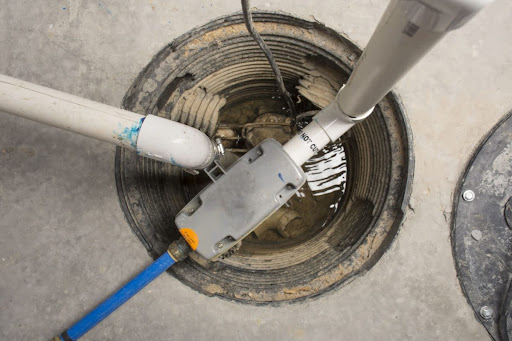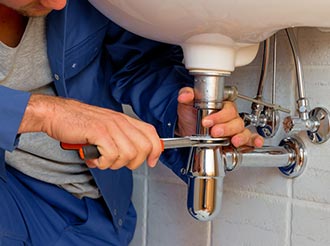
Down in the guts of your home's plumbing system, two types of pumps are often found and used to support your efforts of removing wastewater: the sump pump and the ejector pump. These two machines are absolute workhorses, but they have very different job descriptions. One protects against floods, and the other against basement sewage waste. They both prevent a world of headaches, from flooding to backups, but they satisfy completely different needs.
Do you know which one your home needs to stay dry and functional? Let's find out!
The Sump Pump: What It Does and Why It's Valuable
Think of a sump pump as your basement's bodyguard against flooding. Its whole purpose is to deal with groundwater that seeps in around your foundation.
Your home has a pit, or a "sump," dug into the lowest part of your basement or crawlspace. The sump pump sits inside this pit. As rain or melting snow raises the water table, water fills the pit. Once the water hits a certain level, a float switch is triggered. This switch kicks the pump on, and it sends all that water out and away from your house, usually to a storm drain.
Without a working sump pump, a heavy rainstorm could turn your basement into a swimming pool, damaging everything on the floor and even the structure of your home. It's a simple, powerful defense against Mother Nature.
The Ejector Pump: The Heavy Lifter for Your Below-Grade Bathroom and All Its Wastewater
An ejector pump, sometimes called a sewage ejector pump, tackles a much messier job. This pump is ideal if you have any plumbing fixtures in your basement, such as a toilet, sink, or shower. Because your basement floor is below the level of your home's main sanitary sewer line, gravity can't do the work. You need a pump to lift that wastewater and waste up to the sewer line so it can flow away properly.
Unlike a sump pump that just handles water, an ejector pump is built to move solid waste. It sits in a sealed basin and grinds up sewage and toilet paper before pumping it out. The sealed lid is very important; it keeps nasty sewer gas and odors from escaping into your home.
If you want to add a functional bathroom or laundry room to your basement, an ejector pump is a non-negotiable piece of your plumbing system.
The Sump Pump Shines Brightest When Protecting Your Foundation from Water Damage
The benefits of a sump pump are all about prevention. It’s a quiet system that you only notice when it's not working. By actively managing groundwater, it keeps your basement dry, protects your foundation from the pressure of saturated soil, and stops mold and mildew from taking hold. This directly improves your home's indoor air quality and makes your basement a more usable, pleasant space. Its main job is to prevent a costly water damage disaster.
A sump pump is a great addition for:
- Homes located in areas with heavy rain or snowfall.
- Any house with a basement or crawlspace, especially if it sits below the local water table.
- Property owners who want to finish their basement and protect their investment.
- People looking to avoid the massive expense and headache of a flooded floor.
The Ejector Pump Is Your Go-To for Adding a Functional Bathroom or Laundry Room in Your Basement
The ejector pump's biggest benefit is the freedom it gives you. It unlocks the potential of your basement by allowing you to install plumbing fixtures where gravity works against you. You can add a full bathroom, a wet bar with a sink, or a laundry room downstairs, significantly increasing your home's usable square footage and value. This pump reliably handles the dirty work, moving sewage and wastewater out of your home efficiently.
An ejector pump is the right choice for:
- Homeowners who are planning a basement remodel that includes a toilet, sink, or shower.
- Any property where the basement plumbing will sit lower than the municipal sanitary sewer line.
- People who want to add an extra bathroom to their home without tearing up concrete on the main level.
Mechanics and Maintenance: The Critical Differences That Separate These Two Pumps
Looking at them side-by-side, you'd notice some clear differences. A sump pump deals with clean water, so its discharge pipe is smaller, usually around 1.5 inches. Its pit can be open. The impeller inside is designed to move water quickly.
An ejector pump, however, needs a wider pipe, at least 2 inches, to pass solid waste without clogging. Its pit must be sealed and vented to release sewer gas outdoors. The impeller in an ejector pump is much more robust and built to grind and move thick slurry.
Maintenance is also different. Both pumps should be checked yearly, but the ejector pump's sealed system is a bit more complex. A power outage is a concern for both. A battery backup is a smart investment for a sump pump to prevent flooding during a storm.
S and J Plumbing Has the Right Pump Solution for Your Home
Both sump pumps and ejector pumps are valuable additions that protect and improve your home. One shields you from groundwater damage, while the other makes a basement bathroom possible. Our team at S and J Plumbing has the know-how to install the correct pump for your home’s specific layout and your family’s needs. Contact us today for reliable plumbing and sewer line services, and we'll get your home equipped with the right protection.




